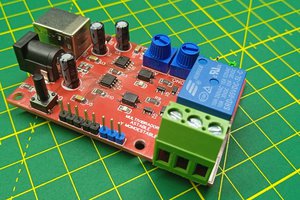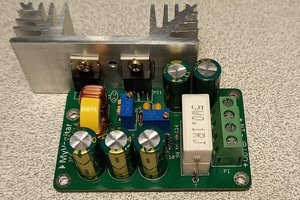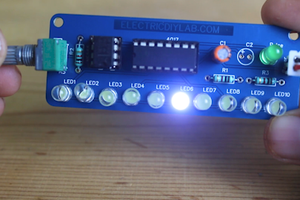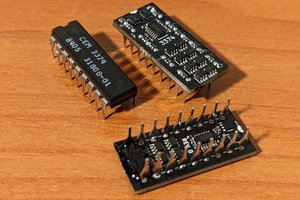The HP 5328 has a 30 pin edge connector for the OCXO option. The HP 10544 unit is in two pieces - a PCB and the insulated oven oscillator itself. This retrofit simply plugs into the 30 pin edge connector and emulates the behavior of the HP 10544. I looked online for the HP 5328 and HP 10544 schematic diagrams, and quickly reverse engineered the interface.
The HP10544 retrofit circuit consists of three sections:
- OCXO voltage regulator
- OCXO output conditioning
- OCXO fine tuning
The OCXO that I used was an Oscilloquartz 8663-XS unit. There are lots of units that share this same physical size and footprint. I imagine that any comparable unit would work just as well. If you find a unit that has a square wave output, you will likely have to simplify/remove the output conditioning circuitry. Also be sure to verify the supply voltage and current requirements of your OCXO if it is of a different type than what I used!
I chose an LM2675-12 to regulate the (nominal) 28VDC supply down to the 12VDC for the OCXO. The HP 5328 mainboard provides the 28V rail continuously, so it made the most sense to me to use a DC-DC switching regulator to keep the PCB small and simple. My observation is that the OCXO does not seem to have any measurable dependence upon supply voltage 'cleanliness'. (DC-DC vs. LDO vs. Lab Supply). An LED indicates that the 12V rail is up. I used the TI Web Bench software to design the regulator for a 1.2A maximum output current, and chose components based upon its recommendations.
The OCXO output is a clipped sine 10 MHz analog output at +4 dBm, which needs to be shifted and squared up to emulate the output of the HP 10544 OCXO. I used a squaring circuit from the Efratom LPRO 101 Rb oscillator datasheet which has worked very well for me in the past. The sine signal is AC coupled, biased to mid-rail, and applied to the input of a fast CMOS inverter. I used a 74AC04. The HP 5328 mainboard provides a switched 5V supply that is active whenever the counter is on, and this is used to power the 74AC04, as well as a second indicator LED. See the LPRO 101 Rb oscillator datasheet for a great comparison of several ways to convert a 10 MHz sine into a 10 MHz square wave.
The fine tuning is simply a 20-turn 10K potentiometer connected across the VREF and GND pins of the OCXO, with the wiper connected to the VFC terminal.
Mechanical design is pretty straightforward. I sized my retrofit PCB to be the same as that of the PCB that interfaces the HP 5328 to the HP 10544. ( HP P/N 05328-60018 ) The Oscilloquartz 8663 OCXO is much smaller and lighter than the old HP 10544, so I am for the time being running without a support post from the retrofit PCB to the internal wall of the HP 5328. This post provided mechanical support to the original OCXO option.
 tomcircuit
tomcircuit


 ElectronicABC
ElectronicABC
 hesam.moshiri
hesam.moshiri
 sandy
sandy
Thanks! I'll take a look and see what I have in the way of PCB. One I sacrificed for another project already, but I suspect I still have one blank PCB remaining.